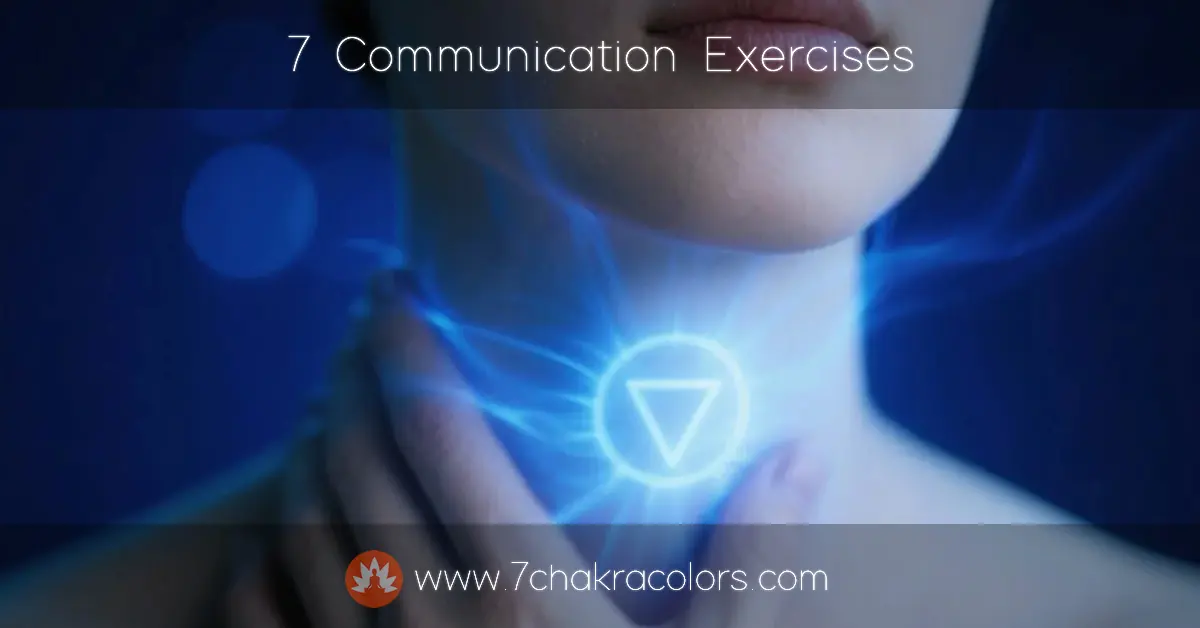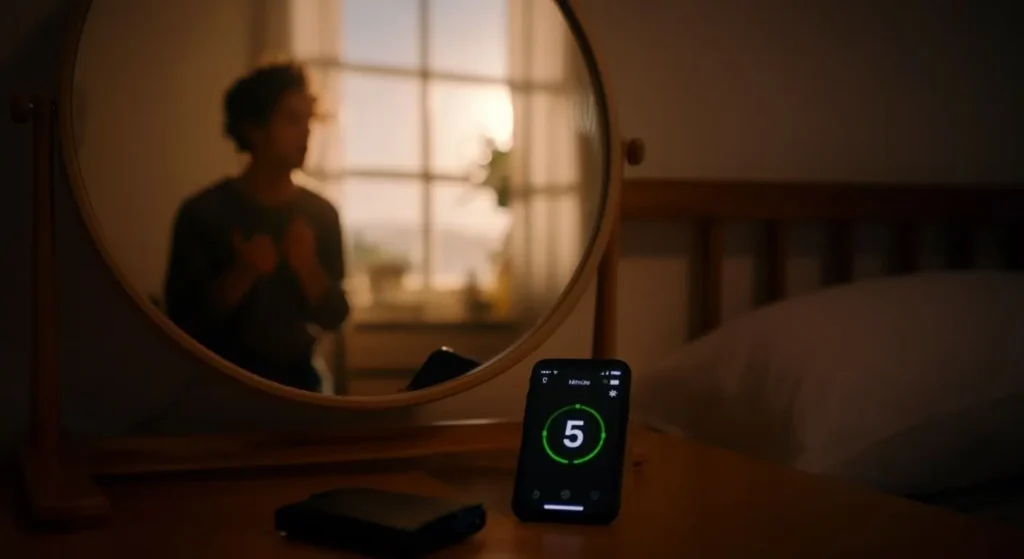

Discover 7 powerful communication exercises to balance your throat chakra. Learn practical techniques to overcome fear of speaking, express emotions authentically, and communicate with confidence in any situation.
Ever try to say something important and watch the words just… not happen? Your throat locks up. Voice cracks or goes quiet. Everything you spent time rehearsing just disappears the moment you actually need it.
This happens constantly. You’re presenting something at work and trip over points you’ve gone through a dozen times in your head. There’s someone you want to talk to – you’ve played out the whole conversation – but when they’re actually standing there, either nothing comes out or you say something so awkward you can’t stop thinking about it for days. Even people you’ve known forever, when emotions get involved and you actually need to say what’s going on, the words get jammed somewhere between your chest and your throat.
That’s not just nerves doing that.
Your throat chakra – the energy center that handles everything about how you express yourself – has been running on old patterns and blocks for years now.
Thing is, you communicate constantly without thinking about it. Ordering coffee. Texting back. Answering questions at work. Your throat chakra stays busy all day – either moving energy through smoothly or getting tangled up in whatever’s blocking it. Most of this happens completely outside your awareness.
Communication isn’t just words coming out of your mouth.
It’s showing who you actually are.
Really hearing what someone else says instead of planning your response. Creating genuine connection through what you say, how you say it, the attention you bring to the exchange. It’s energy moving between people – when that flow gets disrupted or twisted, relating to others becomes way harder.
But here’s something useful: this is trainable.
Like building strength or learning an instrument. Your body picks up patterns, your mind develops habits. Practice the right way and you rewire the whole system. Eventually you show up clearer and more confident without even trying. Your throat chakra just starts working how it should – open, loose, flowing.
These seven exercises target exactly that. Nothing complicated about them, but they work because they put you in actual situations where communication gets difficult.
Most people hate this idea. That discomfort is the whole reason to try it.
Try and approach someone you don’t know and just start to talk to him. Say hi, introduce yourself. You don’t need a goal or a reason – don’t have this fixed in your mind. You’re practicing what it feels like to start contact when you can’t predict what happens next. Let the conversation develop itself organically.

Of course, you’ll need to have some question prepared to break the ice and touch base, make it simple. For example, ask for directions to some place you already know. Say something about whatever’s going on around you – looks like this line’s not moving, weird day for weather, interesting book you’ve got there. The actual topic matters way less than breaking through that initial resistance to engaging with people.
Where do most throat chakra blocks come from?
Fear.
Afraid people will judge you, reject you, think you’re weird. Each conversation with a stranger teaches your nervous system those fears aren’t actually dangerous. Most people respond just fine. Some conversations fizzle out fast and that’s completely okay. Once in a while you have a genuinely good exchange. All of it makes speaking up feel more normal.
If walking up to strangers in person feels like too much right now, start online instead. Platforms exist where you can have conversations with random people worldwide and the pressure’s lower. Something like Minichat connects you with people for video or text chats. Yes, some people use it for dating, but that’s not the only point. The real value is putting yourself in situations where you need to communicate spontaneously with someone brand new.

These platforms work for throat chakra practice because they lower some barriers but keep the core challenge. You still need to express yourself, actually listen, respond authentically, deal with awkward moments. But you can start and stop conversations easier, which means more practice. Your communication naturally gets better. You become more spontaneous with how you talk. The uncertainty that comes with real exchanges stops feeling so threatening. Some people even figure out how to flirt more naturally through this – because flirting is really just playful, honest communication where you’re not overthinking everything.
Do this regularly. Minimum twice a week. You’ll watch the fear drop off and notice yourself expressing things more freely pretty quickly.
Most of us struggle with this. We’re not great at expressing how we actually feel. Something intense happens – someone asks what’s wrong – and without thinking, your brain throws out “I’m fine” or “just tired.” Anything to avoid going deeper into what’s really happening.
This one’s different. You identify what’s actually happening emotionally and say it out loud to another person. Not texting about it later, not journaling – speaking it with your actual voice.

Find someone you trust enough for this. Let them know you’re working on emotional expression and need their help. Then make it regular – ideally daily. Keep the words simple when you describe what’s going on inside.
Something like: “Tomorrow’s presentation has me anxious.” Or: “I keep feeling frustrated, like everything’s going wrong.” Sometimes: “No idea why, but I’m feeling really happy today.” What you say matters less than actually saying it out loud.
Such expressions help open your throat chakra because you express outside something that is happening inside you. Most blocks got built over years of hiding what’s real and only showing what seemed acceptable. This reverses that.
The other person doesn’t need to solve anything or even say much back. You just need the practice of turning internal experience into spoken words.
Get a timer. Set it for five minutes. Pick something you know about – anything works. Now talk about it continuously until the timer stops. Keep going even when it gets uncomfortable. Try to catch yourself before reaching for “um” or “uh” or “like” – those safety nets we all lean on.

This trains fluency. Communication blocks usually happen because your brain’s moving faster than your mouth, or your mouth tries to speak before your brain has the thought ready. This forces them to sync up.
Topic doesn’t matter at all. Walk through how you make your favorite meal. Describe your morning in detail. Talk about some movie you watched recently. Argue one side of something you have opinions about. You’re not practicing content – you’re training the mechanical skill of keeping words flowing.
Start alone. Recording yourself helps because you’ll hear exactly where you stumble, where things stop making sense, where your voice does weird things. After a week of solo runs, try it with someone watching. Stakes go up but the benefit increases too.
Five minutes will feel impossibly long when you’re not used to holding space with just your voice. That’s the whole idea. You’re stretching your capacity.
Communication runs both directions. Your throat chakra handles speaking but also receiving.
Here’s the thing about most people – they don’t actually listen. They’re just waiting. While you’re mid-sentence, they’ve already jumped ahead to what they want to say next. Or worse, they’re filtering your words through their own experiences and judgments instead of just hearing you.
Flip this around. Get someone who’s willing to talk for ten minutes straight about whatever they want while you do nothing except listen. No responding, no jumping in, not even nodding along going “yeah, yeah.” Pure attention on what they’re saying.

When they’re done, repeat back what you heard – not your thoughts about it or what you’d suggest, just the actual words they said. You’ll see how much usually disappears when you’re only half-listening.
Being quiet and truly receiving someone else’s words is as much communication practice as speaking is. Your throat chakra needs both directions working clearly. Get better at listening and your speaking improves too because you understand how communication actually lands in another person.
Try this weekly. Switch roles so you also get the experience of being heard without someone cutting in.
There’s something you need to tell someone and you haven’t. Could be setting a boundary. Saying you appreciate them. Admitting you messed up. Asking for something you want. Whatever it is, it’s sitting in your throat creating pressure.
This exercise is simple but uncomfortable: identify what that thing is and say it within two days.

Perfection isn’t the goal here. The right words don’t exist. Stop sitting around waiting for them. Just open your mouth and say the thing. That knot you feel before saying something hard? That’s years of resistance stored in your throat chakra. Push through it anyway. Each time you do, you’re clearing out more of that old blockage.
Start with smaller stuff if you need to. Bring up that thing that’s been bugging you with your partner. Finally ask your boss the question you’ve been putting off.
Text someone you’d like to get closer to instead of hoping they’ll message you first. The words themselves aren’t what matters – what matters is getting those held-back thoughts out of your system.
Your throat chakra lives in your actual throat. Sometimes the blocks are physical as much as energetic – tight muscles, shallow breathing, tension you’ve been holding for years.
This one uses your voice to release that physical holding. Find somewhere you can be alone. Somewhere you won’t feel weird about making sounds. Take a deep breath, and as it leaves your body, create a long “ah” sound. Not singing, just toning. Notice where it vibrates in your throat and chest.

Try other sounds too: “oh,” “ee,” “mmm.” Each one creates different vibrations in your throat. Spend two minutes just making sounds, letting them be as loud or strange as they want to be. This isn’t about sounding good – you’re moving stuck energy through vibration.
You can also practice your voice at different volumes. Whisper something, then say it normally, then project it loud. Your voice has range you probably never use. Exploring that range wakes up parts of your throat chakra that have been dormant.
Do this daily for a week and watch how your normal speaking voice changes – usually drops deeper and sounds more grounded.
Think of someone whose communication style you admire. Maybe a friend who’s effortlessly social. A public speaker you respect. Even a character from a show who expresses themselves clearly and confidently.
For one whole day, try communicating like that person would. Not copying their voice or how they move – more channeling their energy and approach. They’re bold and direct? Be bold and direct. They’re warm and engaging? Bring that warmth. They listen way more than they talk? Do that.

This works because it temporarily drops your usual patterns and lets you experiment with different ways of showing up. You might find that some approaches feel more natural than you’d expect. You might realize the “you” who’s scared to speak up is just one version – not the only version that exists.
Try different types over different days. Be more assertive one day, more vulnerable another, more humorous the next. Your throat chakra isn’t locked into one mode – it responds to how you choose to show up. This exercise expands your range.
These exercises work because they’re not theoretical. You’re not just reading about communication or thinking about your throat chakra – you’re getting into the exact situations that normally trigger your blocks.
With consistent practice, things shift. That throat tightness before speaking? It starts loosening up. Words come more easily, even in situations that used to shut you down completely. You spend less time rehearsing what you’ll say because you’ve built trust in your ability to handle things on the fly. People respond differently because they’re getting the real you.
Everything runs through your throat chakra – every talk you have, every interaction, every time you choose to speak or keep quiet. Work on it consciously and watch how those automatic moments start flowing better.
Pick one exercise. Do it consistently for two weeks. Then add another. You don’t need all seven happening at once. You just need to start practicing expression until it becomes second nature.
Because that’s what balanced throat chakra energy actually feels like – communication that flows without constant mental management. You speak your truth, listen deeply to others, and let the energy move.
The throat chakra (Vishuddha) is your fifth energy center, located at the base of your throat. It governs all forms of expression – speaking, listening, and authentic self-expression. When balanced, you communicate clearly, express yourself confidently, and listen deeply to others. When blocked, you might struggle with public speaking, fear judgment, have difficulty expressing emotions, or feel like your voice doesn’t matter. Physical symptoms of throat chakra imbalance include a tight throat, frequent throat clearing, or feeling like words get stuck before you can say them.
Most people notice initial improvements within 2-3 weeks of consistent daily practice. Simple changes appear first – less anxiety before speaking, words flowing more easily in casual conversations. Significant shifts in public speaking confidence or emotional expression typically take 6-8 weeks of regular practice. Deep-seated blocks from years of suppressing your voice may need several months of dedicated work. The key is consistency – practicing these exercises 4-5 times per week produces better results than occasional intense sessions.
Yes, absolutely. Social anxiety often stems from blocked throat chakra energy combined with fear-based thinking. These exercises work on both levels – the physical practice of speaking to strangers retrains your nervous system to recognize that social interaction isn’t dangerous, while the energy work clears blocks that make expression feel threatening. Many people report significant reduction in social anxiety after 4-6 weeks of consistent practice, particularly with the stranger conversation and active listening exercises which directly address the core fears.
No. These exercises work whether you believe in energy centers or not because they’re fundamentally communication skills training. Talking to strangers builds confidence through exposure therapy. Speaking emotions out loud creates neural pathways for emotional expression. Active listening improves your ability to be present. The vocal toning exercises physically release tension in your throat muscles. The chakra framework simply provides a useful way to understand why certain communication blocks exist and which exercises target them most effectively.
Start with the five-minute monologue practice alone, recording yourself. This removes the pressure of an audience while building the mechanical skill of sustained speaking. After one week of solo practice, add the vocal toning exercises to release physical throat tension. Then move to speaking emotions out loud with one trusted person. Only after these feel comfortable should you progress to stranger conversations or public speaking situations. Building gradually prevents overwhelming your system and creating more blocks.
Online conversations through platforms like Minichat offer a valuable middle step between solo practice and in-person interaction. They provide real-time communication practice with actual people but with slightly lower stakes – you can end conversations more easily, there’s physical distance, and you control your environment. However, in-person conversations add body language, spatial dynamics, and higher nervous system activation, making them more challenging but ultimately more effective for throat chakra work. Use online practice as a stepping stone, not a replacement for face-to-face communication.
Yes. Common physical symptoms include chronic throat clearing, tight throat sensation, frequent sore throats without infection, TMJ or jaw tension, neck pain or stiffness, thyroid issues, and even dental problems. Some people experience voice changes – speaking more quietly than natural, voice cracking under stress, or losing their voice in important moments. These physical manifestations often improve alongside the communication blocks as you work through the exercises, though persistent symptoms should be evaluated by a healthcare provider.
Emotional release is completely normal and actually indicates the exercise is working. Years of suppressed emotions often surface when you finally give them voice. Crying, anger, or intense feelings during emotional expression exercises mean energy is moving through blocks. This is healthy. However, if you feel consistently overwhelmed, slow down – work with emotions that feel less intense first, practice for shorter periods, or work with a therapist alongside these exercises. The goal is sustainable release, not retraumatization.
For best results, practice at least one exercise daily. You don’t need to do all seven every day – that’s overwhelming and unsustainable. Pick one or two exercises that target your biggest communication blocks and make them daily habits for two weeks. Then add another exercise. The stranger conversation practice works well 2-3 times per week. Emotional expression and vocal toning benefit from daily practice. Active listening can be incorporated into existing conversations. Consistency matters far more than duration – five minutes daily beats an hour once a week.
Definitely. Flirting is authentic, playful communication without excessive self-consciousness – exactly what balanced throat chakra energy enables. The stranger conversation practice is particularly effective because it removes outcome attachment while building spontaneous expression skills. The role reversal exercise lets you experiment with more playful or bold communication styles. As your throat chakra opens, you naturally become more present, genuine, and comfortable with uncertainty in conversations, which makes romantic communication feel less scripted and more natural.